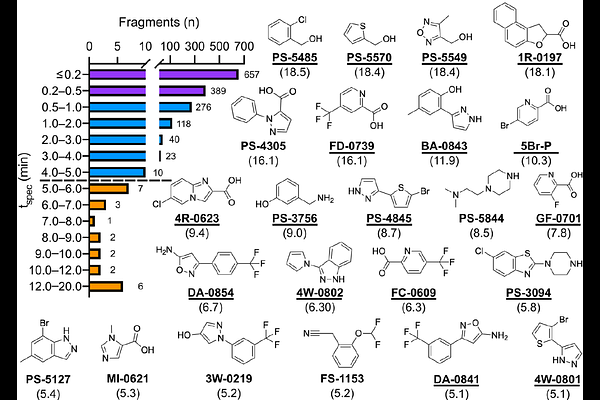Fragment Screening by Weak Affinity Chromatography Identifies Ligands for Neisseria gonorrhoeae Undecaprenyl Diphosphate Synthase

Fragment Screening by Weak Affinity Chromatography Identifies Ligands for Neisseria gonorrhoeae Undecaprenyl Diphosphate Synthase
Santiago, A. d. S.; Amaral, B. S.; Llontopp, E.; Ramos, P. Z.; Souza, L. R.; Cunha, M. R.; Piccirillo, E.; Almeida, V. M.; Pilli, R. A.; Barreiro, G.; Massirer, K. B.; Counago, R. M.
AbstractThe rapid rise of antimicrobial resistance in Neisseria gonorrhoeae underscores the urgent need for new therapeutic strategies. Undecaprenyl diphosphate synthase (UPPS), an essential enzyme in bacterial cell wall biosynthesis, has emerged as a promising antimicrobial target. However, no structural information has been available for the gonococcal enzyme (NgUPPS), and known ligand scaffolds remain limited, hindering structure-based drug discovery efforts. Here, we present a combined weak affinity chromatography-mass spectrometry (WAC-MS) and crystallographic pipeline to identify and structurally characterize fragment binders of NgUPPS. WAC-MS screening of a diverse fragment library identified 23 putative binders, 16 of which were successfully co-crystallized with NgUPPS, primarily via soaking into preformed apo crystals. The resulting high-resolution structures mapped fragment binding across four distinct regions of the enzyme\'s hydrophobic tunnel, encompassing the pyrophosphate-binding pockets and the distal product-binding site. Additionally, we determined the co-crystal structure of NgUPPS with BPH-1100, a known phthalic acid-based UPPS inhibitor, revealing that the enzyme adopts an open, ligand-competent conformation without significant rearrangement. Our results validate NgUPPS as a structurally tractable antibacterial target and provide a strong foundation for fragment-based optimization and the future development of novel inhibitors to combat drug-resistant N. gonorrhoeae.